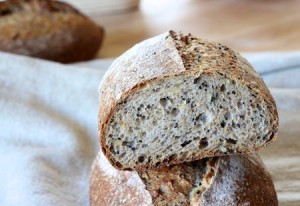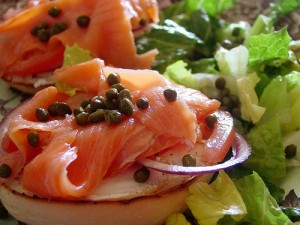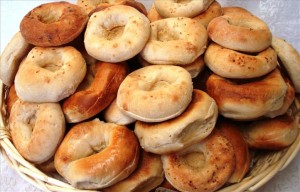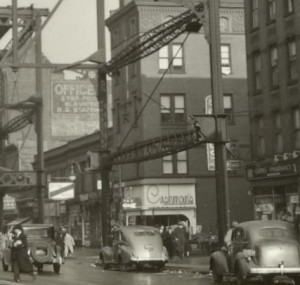HG often longs for the great breads of HG’s Bronx youth. Rye bread. Pumpernickel bread. Bialys. Onion “pletzels” (rolls). A number of grocers offer “Jewish” rye bread. HG believes this is an affront that calls for investigation by the B’nai Brith Anti-Defamation League or even more drastic action by the Jewish Defense League. Dismal present day for HG’s favorites. Pumpernickel bread? Insipid. Bialys? Other than Kossar’s, they are pale imitations without that unique oniony flavor. “Pletzels” ? They’ve disappeared. Bagels, of course, are a sardonic joke. HG doesn’t care because HG never liked bagels. Bagel lovers deserve the nasty chocolate chip and cinnamon raisin bagels now being offered. However, there’s hope. Recently, HG ordered Zabar’s sourdough seeded Jewish rye and Russian pumpernickel bread. Made HG’s eyes misty. These are the authentic loaves. Topped with scallion cream cheese and smoked fish. HG devours many slices with glasses of icy vodka (This regime draws frowns from BSK but HG shakes off disapproval). Another happy note concerning traditional Jewish baked goods. Restaurateur Daughter Victoria sent HG some “Traditional Raspberry Rugelach” (from Russ & Daughters). Spectacular. Sorry, Mom in Heaven, better than yours.
Best Baked Goods
November 20th, 2014 § 0 comments § permalink
Bagels? Feh!
May 4th, 2014 § 0 comments § permalink
Mark Bittman has a nice opinion piece in the New York Times about the perennial Holy Trio (pardon the sacrilege) of Jewish comfort food: Lox, Bagels, Cream Cheese. HG is a bit of a contrarian and curmudgeon on this subject. HG loathes bagels. HG shares this dislike with his late parents, both Jewish immigrants from Belorussia. Every Sunday morning throughout HG’s childhood, HG and his father would stroll to West Kingsbridge Road in The Bronx. They would separate. Father went to the “appetizing” store for Nova salmon, sable, sour pickles, black olives, cole slaw and potato salad. HG went to the bakery for bialys, onion rolls (pletzels) and sliced Jewish rye bread. (Mom had gone to Daitch Dairy the day before for cream cheese and baked farmer cheese). HG picked up the Sunday Times, Sunday News and the Yiddish-language Jewish Daily Forward. Home for the feast at a table with a steaming pot of coffee, a pitcher of freshly squeezed orange juice and a bottle of Hennessy Brandy. A morning of down home Jewish culinary delight. And, not a bagel in sight.
Christmas Restaurant Nostalgia Part 4: Paramount Dairy
December 15th, 2013 § 0 comments § permalink
When HG/BSK lived (with famille) in their spacious rent controlled paradise on New York’s W. 79th Street, HG would escape from the Christmas holiday jingles and saccharine melodies by visiting a stronghold of traditional Jewishness: Paramount Dairy Restaurant on W. 72nd. The stroll on Broadway during the Upper West Side’s pre-gentrification days was always interesting. HG passed culinary landmarks like Daitch Dairy, Babka Bakery, Izmir Pizza, Gitlitz Delicatessen, Citarella Fish Monger. Fellow strollers included junkies, female sex workers, muggers, burglars, crazy ladies talking to themselves, sad eyed refugees from the Nazi terror; and, the usual crowd of West Side intellectuals, artists, writers and bohemians. On almost every block, HG would pause for a chat with a friend or acquaintance. Once in the Paramount, HG was seated at a table adorned with a huge bowl of breadstuffs — each the best of its kind: rye and pumpernickel bread, bialys, pletzels, challah. A dozen pats of unsalted butter. No Christmas decorations. No Chanukah decorations (not even a minor league menorah). Very refreshing. HG would order warm gefilte fish (a note to the uninitiated–this is a fresh water fish dumpling, a Jewish quenelle). This was served in a bowl of fish broth with a boiled potato and carrot. Accompanied by blazing horse radish. HG would dip thick slices of challah in the fish broth. Very comforting. This was followed by kasha varnishkes with mushroom gravy (HG recently wrote about this dish). Many cups of coffee and overindulgence in buttered bialys and pletzels. Refreshed and Judaized, HG was then ready for another onslaught of Bing Crosby and “Silent Night.”
Bloomsday
June 23rd, 2012 § 1 comment § permalink
June 16 was Bloomsday a day of celebration and commemoration of the life of the writer James Joyce and his extraordinary novel, Ulysses. The day refers to the June 16 in the novel. The day in which all of the action takes place during the one day peregrinations throughout Dublin of its Jewish hero (or anti-hero), Leopold Bloom. HG was introduced to the wonders of Joyce in his CCNY college days by Prof. Theodore Goodman, a legendary figure at City College. Goodman taught a course devoted to writing short stories. Students wrote stories. Read them aloud. These were then criticized by Goodman and fellow students. Criticism was withering. To say the least, punches were not pulled. The class text was Joyce’s collection of short stories, Dubliners. The Joyce stories were meticulously analyzed under Goodman’s direction. We leaned there were no accidents in these stories. They were pieces of prose architecture, each word essential in the total framework. It was a humbling experience for embryonic writers. Goodman was elderly and in frail health. Sometimes he missed a class. HG and his mates waited outside the classroom hoping that he would show up. There was a feeling of dread. We loved him, even though he was no Mr. Chips. He was tough and his one-to-one conferences with students could be a scalding experience. Goodman lived through his class with HG and gave HG an “A.” Whenever experience lowers HG’s self esteem, HG remembers that “A.”
In a recent review in The Economist of a Joyce biography by Gordon Bowker, the reviewer noted: “The hero of ‘Ulysses’, Leopold Bloom, was born out of Joyce’s affection and fascination with Jewish culture; which would lead him, in turn, to help several Jewish men and women escape Austria and Germany during the second world war.” It would have been appropriate for HG to celebrate Bloomsday by accompanying a bialy with cream cheese with a glass of Dublin-brewed Guiness Stout. But, in the absence of bialys in New Mexico, HG had to be content in raising a snifter of kosher Slivovitz to the memory of Joyce, a gifted (and difficult) man.
Later this year, during the Christmas season, HG and BSK will watch The Dead, the John Huston cinema version of the longest story in Dubliners. In HG’s opinion, this is the finest cinema version of prose fiction ever achieved.
When Muffins Met Modernism & A Jewish Bakery Detour
June 13th, 2012 § 0 comments § permalink
In 1930s New York, many apartment buildings, shops (and restaurants) were designed in a streamlined, modernist style — a kind of Art Deco for the masses. While true Art Deco (which reached its height in Paris of the 20s and 30s) was very elegant and seriously luxurious, the young American designers who piggy backed on the Art Deco style were a bit more egalitarian. Their best efforts, in terms of major structures, can be seen in the apartment houses that line the Grand Concourse in the Bronx and the glorious hotels of Miami’s South Beach. Smaller design gems were the chain bakeries that flourished in all of New York’s neighborhoods. The aim of all the “streamlining” was to give shoppers an optimistic lift in the gloom of the Great Depression. The “streamlined” bakeries were Cushman’s and Hanscom’s. The famed industrial designer Raymond M. Loewy designed Cushman’s and Horace Ginsbern designed Hanscom’s. (Ginsbern, then fairly young, later became one of New York’s most prominent apartment house architects. Ginsbern was born in 1893 and died in 1969. Scores of his buildings exist in Manhattan’s Upper East Side).
The architect Robert A.M. Stern has commented on the Loewy and Ginsbern bakery designs: “They brought a relatively high level of International Style Modernism into virtually every New York neighborhood.”
Cushman’s had white porcelain facades; nautical, oval windows and the name was spelled out in a curving, gold script. Hanscom’s had apple green porcelain facades and the name was formed with blocky, super- modern letters. Stern described the entire architectual composition as “Constructivist.”
In the Bronx you had Jewish Bakeries and Italian bakeries. The Jewish bakeries had elaborate butter cream cakes and, of course, bagels, bialys, rye and pumpernickel bread, etc. These were jammed on Sunday mornings with Dads buying bread-stuffs for brunch (The casual tweed and camel hair jackets many of them wore were known as “bagel coats”). The Italian bakeries, in neighborhoods like Belmont, had, of course, sublime bread, delicious cannolis, pignoli cookies and other Italian specialties. There was plenty of cross pollination. Jews liked the corn muffins and cookies at Cushman’s and Hanscom’s (which were generalized as goyish bakeries) and there were plenty of bagel and rye bread fanciers among the non-Jewish population. And, of course, everyone loved their Italian baked goods. Some Jewish bakery survivors in Manhattan are Moishe’s Bakery on 2nd Ave, Streit’s, which bakes and sells matzos, macaroons, kichel and other stuff from a 47,000 foot factory on Rivington Street and Kossar’s which bakes and sells bialys and other traditional good stuff from a location near the Essex Street Market. SJ sent HG a batch of Kossar’s products a few months ago producing moans of delight. The eminent food writer, Mimi Sheraton, a woman who knows Jewish food, says a Kossar’s bialy is the only true bialy baked in the United States. HG agrees.
Interestingly, HG’s Mom never called a bialy by that shortened name. She paid appropriate homage by calling it a Bialyosteker Kuchen.




